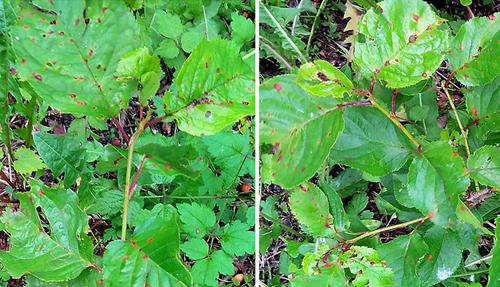当前位置:
X-MOL 学术
›
Ann. Appl. Biol.
›
论文详情
Our official English website, www.x-mol.net, welcomes your
feedback! (Note: you will need to create a separate account there.)
Pseudomonas cerasi, the new wild cherry pathogen in Serbia and the potential use of recG helicase in bacterial identification
Annals of Applied Biology ( IF 2.2 ) Pub Date : 2021-07-02 , DOI: 10.1111/aab.12717 Renata Iličić 1 , Aleksandra Jelušić 2 , Sanja Marković 2 , Goran Barać 1 , Ferenc Bagi 1 , Tatjana Popović 3
Annals of Applied Biology ( IF 2.2 ) Pub Date : 2021-07-02 , DOI: 10.1111/aab.12717 Renata Iličić 1 , Aleksandra Jelušić 2 , Sanja Marković 2 , Goran Barać 1 , Ferenc Bagi 1 , Tatjana Popović 3
Affiliation

|
In May 2016, an unusual appearance of leaf spot (water-soaked, brown-purple, round to angular surrounded with yellow halos) was observed on the leaves of wild cherry specimens grown in Rimski Šančevi, Vojvodina (North Serbia). The causal pathogen was isolated from the wild cherry diseased leaves on Nutrient Agar supplemented with 5% sucrose and identified as Pseudomonas cerasi based on multilocus sequence analysis (MLSA). PCR amplification and sequencing of four housekeeping genes—gapA, gltA, rpoD and gyrB—showed 100% (gapA, gltA), 99.81% (rpoD) and 99.67% (gyrB) identity with P. cerasi type strain CFBP8305T (=58T = LMG28609T) and strain PL963 sequences from NCBI database. Pseudomonas cerasi isolates (coded as RE10-RE19) were LOPAT +− − − + (Pseudomonas Group Ia) and GATTa + − + −, produced fluorescent pigment, were able to utilise lactic and aspartic acid, but not tartaric acid. All isolates were pathogenic on wild cherry seedlings and leaves, immature sweet and sour cherry fruitlets, as well as on lilac leaves and green bean pods. This study also aimed to design new primers (recG-F/recG-R) for amplification of recG gene (encoding ATP-dependent DNA helicase RecG) known for its crucial role in DNA recombination and repair. Amplification of this gene enabled high identification ability of our wild cherry isolates as well as isolates belonging to the closely related stone fruit pathogenic Pseudomonas species. The obtained results highlight the potential of using recG gene for the specific detection and the identification of pathogenic Pseudomonas syringae complex. This research presents the first report of P. cerasi infecting wild cherry as well as first description of this bacterium in Serbia. Obtained results indicate the risk from further spread of this bacterium with the infected cherries rootstock, having a key role in its epidemiology.
中文翻译:

Pseudomonas cerasi,塞尔维亚新的野樱桃病原体以及 recG 解旋酶在细菌鉴定中的潜在用途
2016 年 5 月,在伏伊伏丁那(北塞尔维亚)的 Rimski Šančevi 种植的野樱桃标本的叶子上观察到了不寻常的叶斑(水浸、棕紫色、圆形至角状,周围环绕着黄色光晕)。致病菌从野樱桃病叶中分离,在添加了 5% 蔗糖的营养琼脂上进行,并基于多位点序列分析 (MLSA)鉴定为假单胞菌(Pseudomonas cerasi)。四种看家基因(gapA、gltA、rpoD和gyrB)的PCR 扩增和测序结果显示,与P. cerasi具有100% ( gapA、gltA )、99.81% ( rpoD ) 和 99.67% ( gyrB ) 同一性型菌株 CFBP8305 T (=58 T = LMG28609 T ) 和来自 NCBI 数据库的菌株 PL963 序列。假单胞菌分离株(编码为 RE10-RE19)是 LOPAT +- - - +(假单胞菌组 Ia)和 GATTa + - + -,产生荧光色素,能够利用乳酸和天冬氨酸,但不能利用酒石酸。所有分离株对野樱桃幼苗和叶子、未成熟的酸甜樱桃果实以及丁香叶和绿豆荚均具有致病性。本研究还旨在设计用于扩增recG 的新引物(recG-F/recG-R)基因(编码 ATP 依赖性 DNA 解旋酶 RecG)以其在 DNA 重组和修复中的关键作用而闻名。该基因的扩增使我们的野樱桃分离物以及属于密切相关的核果病原假单胞菌物种的分离物具有很高的识别能力。获得的结果突出了使用recG基因进行特异性检测和鉴定致病性丁香假单胞菌复合物的潜力。这项研究提出了第一份关于P. cerasi感染野樱桃的报告,以及在塞尔维亚对这种细菌的首次描述。获得的结果表明,这种细菌可能会随着受感染的樱桃砧木进一步传播,这在其流行病学中起关键作用。
更新日期:2021-07-02
中文翻译:

Pseudomonas cerasi,塞尔维亚新的野樱桃病原体以及 recG 解旋酶在细菌鉴定中的潜在用途
2016 年 5 月,在伏伊伏丁那(北塞尔维亚)的 Rimski Šančevi 种植的野樱桃标本的叶子上观察到了不寻常的叶斑(水浸、棕紫色、圆形至角状,周围环绕着黄色光晕)。致病菌从野樱桃病叶中分离,在添加了 5% 蔗糖的营养琼脂上进行,并基于多位点序列分析 (MLSA)鉴定为假单胞菌(Pseudomonas cerasi)。四种看家基因(gapA、gltA、rpoD和gyrB)的PCR 扩增和测序结果显示,与P. cerasi具有100% ( gapA、gltA )、99.81% ( rpoD ) 和 99.67% ( gyrB ) 同一性型菌株 CFBP8305 T (=58 T = LMG28609 T ) 和来自 NCBI 数据库的菌株 PL963 序列。假单胞菌分离株(编码为 RE10-RE19)是 LOPAT +- - - +(假单胞菌组 Ia)和 GATTa + - + -,产生荧光色素,能够利用乳酸和天冬氨酸,但不能利用酒石酸。所有分离株对野樱桃幼苗和叶子、未成熟的酸甜樱桃果实以及丁香叶和绿豆荚均具有致病性。本研究还旨在设计用于扩增recG 的新引物(recG-F/recG-R)基因(编码 ATP 依赖性 DNA 解旋酶 RecG)以其在 DNA 重组和修复中的关键作用而闻名。该基因的扩增使我们的野樱桃分离物以及属于密切相关的核果病原假单胞菌物种的分离物具有很高的识别能力。获得的结果突出了使用recG基因进行特异性检测和鉴定致病性丁香假单胞菌复合物的潜力。这项研究提出了第一份关于P. cerasi感染野樱桃的报告,以及在塞尔维亚对这种细菌的首次描述。获得的结果表明,这种细菌可能会随着受感染的樱桃砧木进一步传播,这在其流行病学中起关键作用。











































 京公网安备 11010802027423号
京公网安备 11010802027423号